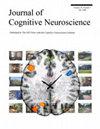Changes in Brain Functional Connectivity Underlying the Space–Number Association
IF 3.1
3区 医学
Q2 NEUROSCIENCES
引用次数: 0
Abstract
Whether small number magnitudes are inherently represented as lying to the left of larger ones, the space–number association (SNA), is an important issue in mathematical cognition. In this fMRI study, we used a go/no-go implicit association task to investigate the brain activity and functional connectivity underlying the SNA. Arabic digits lower or higher than 5 and left- or right-pointing arrows were alternated as central targets. In a single-code task condition, participants responded to a specific number magnitude and to all arrows or to a specific arrow direction and to all number magnitudes. In a joint-code (JC) condition, responses were provided after congruent, for example, “go when a number is lower than 5 or an arrow points left,” or incongruent, for example, “go when a number is lower than 5 or an arrow points right,” SNAs. The SNA was only found in the JC condition, where responses were faster with congruent instructions. Analyses of fMRI functional connectivity showed that the SNA was matched with enhanced excitatory inputs from ACC, the left TPJ, and the left inferior frontal gyrus to the left and right intraparietal sulcus (IPS). Incongruent JC trials were associated with enhanced excitatory modulation from ACC to the left and right IPS. These results show that the SNA is associated with enhanced activation of top–down brain control and changes in the functional interaction between the left and right IPS. We conclude that the SNA does not depend on an inherent and bottom–up spatial coding of number magnitudes.大脑功能连接性的变化是空间与数字关联的基础
空间数联想(SNA)是数学认知中的一个重要问题。在这项 fMRI 研究中,我们使用了 "走/不走 "内隐联想任务来研究空间数联想的大脑活动和功能连接。小于或大于 5 的阿拉伯数字和向左或向右的箭头交替作为中心目标。在单一代码任务条件下,参与者对特定数字大小和所有箭头做出反应,或对特定箭头方向和所有数字大小做出反应。在联合代码(JC)条件下,参与者会在一致(例如 "当数字小于 5 或箭头指向左边时走")或不一致(例如 "当数字小于 5 或箭头指向右边时走")的 SNA 后做出反应。只有在 JC 条件下才会出现 SNA,而在同向指令条件下反应更快。对 fMRI 功能连接的分析表明,SNA 与从 ACC、左 TPJ 和左额叶下回到左右顶内沟(IPS)的兴奋性输入增强相匹配。不一致的 JC 试验与来自 ACC 至左侧和右侧 IPS 的兴奋调节增强有关。这些结果表明,SNA 与自上而下的大脑控制激活增强以及左右 IPS 之间的功能互动变化有关。我们的结论是,SNA 并不依赖于固有的、自下而上的数字幅度空间编码。
本文章由计算机程序翻译,如有差异,请以英文原文为准。
求助全文
约1分钟内获得全文
求助全文
来源期刊
CiteScore
5.30
自引率
3.10%
发文量
151
审稿时长
3-8 weeks
期刊介绍:
Journal of Cognitive Neuroscience investigates brain–behavior interaction and promotes lively interchange among the mind sciences.

 求助内容:
求助内容: 应助结果提醒方式:
应助结果提醒方式:


